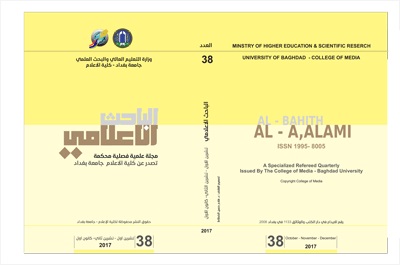The Diversity of Cultures and Ideologies in Society and its Impact on the Structure of Iraqi press
DOI:
https://doi.org/10.33282/abaa.v9i38.86Keywords:
Diversity, cultures, ideologies, society, the Iraqi pressAbstract
The diversity of cultures is still the title of an Iraqi specificity that gave the society a diversity and this is reflected in the journalistic reality with the changing of the political system generate a new political and ideological life that differs from what is prevailed during the decades. However, its exacerbation of the degree of division is an additional duty for the press as a cultural platform and a knowledge bridge that contributes to the process of dialogue, addressing the differences, establishing a politically homogeneous structure through the state and socially by uniting all components of society and working to raise public awareness of the importance of national belonging to build a modern state. Cultural diversity is a human moral and intellectual necessity that leads to peaceful coexistence and building a human being who respects values and freedom of expression and opinion in order to create modern institutions and a civilized society based on tolerance and exchange of ideas. Therefore, the gradual transformation of political reality led to the challenge of press which indicates media in how to contribute to the process of repairing cracks and confront the ideological differences and prevailing cultures. One of the most prominent of this difficult stage is the occurrence of deadly doublets and dynasties in Iraqi cultural structures. The contemplative historian senses that two basic lines of Iraqi intellectuals have been starting together since the formation of the state and they contribute to live in conflict between them in 2003 after the defeat of the state and the laxity of society. This is reflected in an Iraqi political-national cultural line that represents the radical-socialist trend which began utopian, class-oriented and Marxist at the parties. While the second line represent the national trend and later ideologically envied by the parties and national groups. The decline of the two trends has led to a different cultural and ideological direction that represent political Islam and its control over the political and societal reality, taking advantage of the failure of those forces in the two previous directions. To conflict in the structure of culture with the invention of regional and international shares in situation of plowing the mental and unconscious infrastructure of the individual reflected on the cultural environment of the community to live a kind of turmoil, which led to different trends in the structure of press in accordance with the variables to produce a speech. It is a sign of the new reality. The press has been a manifestation of change that has been associated with the political system and its relationship to the nature of the facts of the new environment. Therefore, there is a link between the evidence of the press and the possibility of forming an ideology that is consistent with the cultural structure by means of various information, news, analysis, article, and the possibility of controlling external press institutions and the work controls that govern the structure of the institutions internally. These restrictions and restrains have defined the path by which each press organization operates through its structure of human staff. And the capital which is the core and the starting point for the establishment and the continuation of the existence of the means and then the goals embodied in the speech that is characterized by this newspaper or that in the production of ideas and opinions, information and texts and they deal to communicate to the public to influence the trends and their tendencies and not to employ diversity and marketing through the various media in its ideological tendencies leading to division and then to a social and political conflict.
Downloads
References
الدكتور صالح خليل أبو أصبع ، إدارة المؤسسات الإعلامية في الوطن العربي ، دار آرام للدراسات والنشر ، عمان – الأردن ، 1997 ، ص84 .
الدكتور محمد حسام الدين ، المسؤولية الاجتماعية للصحافة ، الدار المصرية اللبنانية ، القاهرة ، 2003 ، ص100 .
إبراهيم عبدالله المسلمي ، الإعلام والمجتمع ، ط2 ، دار الفكر العربي ، القاهرة ، 2007 ، ص80 .
محمد عبد الحميد ، نظريات الإعلام واتجاهات التأثير ، عالم الكتب ، القاهرة ، ص127.
الدكتور محمود علم الدين ، م . س . ذ ، ص60 .
الدكتور محمود علم الدين ، م . س . ذ ، ص112 .
الدكتورة سحر خليفة سالم الجبوري ، تنمية القدرات الإدارية للمؤسسات الإعلامية ، دار المدى ، بيروت ، 2012 ، ص121 .
الدكتور محمد حسام الدين ، م . س . ذ ، ص196 .
الدكتور صالح أبو أصبع ، م . س . ذ ، ص94 .
الدكتور علي ناصر كنانة ، م . س . ذ ، ص72 .
آرثر آسابيرغر ، م . س . ذ ، ص80 .
جان ل شابمان ، نيك نوتان ، الصحافة اليوم ، ترجمة د . أحمد المغربي ، دار الفجر للنشر والتوزيع ، القاهرة ، 2012 ، ص256 .
الدكتور صالح أبو أصبع ، م . س . ذ ، ص87 .
الدكتور علي ناصر كنانة ، م . س . ذ ، ص72 .
الدكتور علي ناصر كنانة ، نفس المصدر ، ص72 .
الدكتور صالح أبو أصبع ، م . س . ذ ، ص88 .
أديث كيرزويل ، عصر البنيوية ، ترجمة جابر عصفور ، دار آفاق عربية للصحافة والنشر ، بغداد ، 1985 ، ص270 .
ناجح المعموري ، انثروبولوجيا الثقافة .. والعلاقة بين الجماعات ، جريدة المدى ، العدد 3778 ، 8/10/2016 ، ص13 .
الدكتور وسام فاضل وآخرون ، اتجاهات إعلامية .. دراسات في مجال التأثير الجماهيري والدولي لوسائل الإعلام ، مركز حمورابي للبحوث والدراسات الإستراتيجية ، بيسان للنشر والتوزيع ، بيروت ، 2011 ، ص60 .
الدكتور محمد حسام الدين ، م . س . ذ ، ص172 .
سوفي مواران ، خطاب الصحافة اليومية ، ترجمة عبد المجيد جحفة ، الدار العربية للعلوم ناشرون ، بيروت ، 2009 ، ص204 .
د. سيد بخيت ، العمل الصحفي في مصر دراسة سسيولوجية للصحفيين المصريين، العربي للنشر والتوزيع، القاهرة، ط1، 1998، ص39.
Downloads
Key Dates
Published
Issue
Section
License
Authors retain copyright and grant the journal right of first publication with the work simultaneously licensed under a Creative Commons Attribution License (CC BY 4.0) that allows sharing the work with recognition of authorship and initial publication in ABBA journal.


















